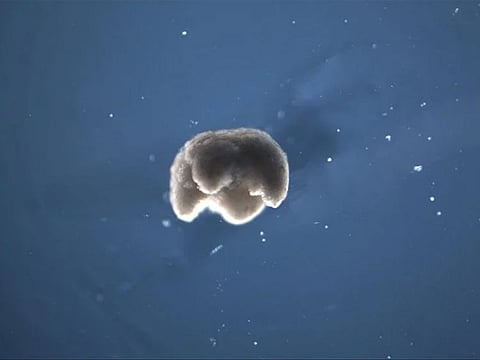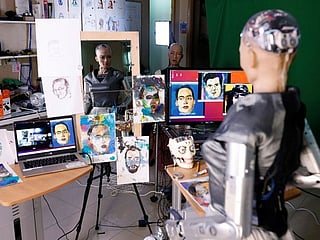These living robots made of frog cells can now reproduce, study says
Xenobots could already move around, display collective behavior, heal themselves

The robots are alive, and now they can reproduce.
That's not a sequel to "The Terminator." It's the result of new research showing that microscopic life-forms made of frogs' stem cells can self-replicate in a way not seen in other animals or plants.
These xenobots, named for the African frog Xenopus laevis from which they are made, could already move around, display collective behavior and heal themselves. A study released Monday suggests that the cell clumps also can be engineered to sustain themselves for at least five generations.
"There's nothing theoretical that would stop us from making these out of human cells," said Sam Kriegman, an author of the study published in the journal Proceedings of the National Academy of Sciences (PNAS). "They could perform useful work inside of human bodies in places were traditional robots can't go because our bodies detest even the smallest amount of metal."
That kind of potential application lies far in the future. Kriegman, a postdoctoral fellow at Harvard University and Tufts University, said the xenobots are not yet usable but could lead to technology capable of corralling microplastic from the ocean into a retrievable ball or delivering medicine to a specific spot in a person's body.
The finding that xenobots can reproduce is the latest result of research that began in 2018 among biologists and computer scientists at Tufts, Harvard and the University of Vermont. The researchers took stem cells from the skin of frog embryos and put them in salt water, where they clumped together into spheres with a layer of cilia, which are akin to small hairs and enable the organisms to move.
The scientists noticed that the xenobots were swimming around randomly and would spontaneously make piles out of particles placed in the dish, like dye or silicone-coated iron beads. One of the biologists started to wonder whether the tiny robots would do the same thing with individual stem cells, so he drew up a test.
The experiment worked.
"Once he did that and showed us the video, there was a definitely a record scratch," Kriegman said. "The first thing we thought of was robots building robots, which has been a dream of robotics since the very beginning."
Knowing that xenobots' shapes affect their behavior, the computer scientists then ran algorithms to figure out which form would help the organism to replicate repeatedly. They discovered that a "C" shape resembling Pac-Man from the 1980 video game series seemed to be best, and one of the biologists used microsurgical tools to carve the xenobots into that design.
As the algorithms predicted, the Pac-Man-shaped xenobots gathered individual stem cells into clusters, which became xenobots of their own. This type of replication is based on the organisms' movement, rather than growing and then shedding a new being as other animals and plants do, Kriegman said.
Xenobots straddle an unusual line between living organisms and robots. They are organisms because they are made of stem cells and can reproduce. But they are also robots because they can move on their own and perform physical labor, Kriegman said. Although most robots are made of metal, he said robots are defined not by their material, but by what they can do.
Before now, Kriegman said, "no one has been using living materials as self-moving, self-powered robots."
The researchers hope that the xenobots can help them better understand the process of replication - a fundamental property of life - and how to control it. Faced with a world full of self-replicating problems, such as the novel coronavirus and forest fires, Kriegman said studying xenobots could lead scientists closer to solutions.
The next step in the research is trying to build similar living robots out of mammal cells with a goal of eventually creating robots that can act without human oversight. That work comes with ethical questions.
"If we start to create these things to be more and more intelligent," Kriegman said, "at some point, there needs to be additional ethical considerations."
To those unnerved by the idea of reproducing robots, Kriegman said only a fragile set of easily changeable circumstances leads the xenobots to self-replicate.
"If you change the amount of sodium in that water to be too high or too low, they'll die," he said. "If there's a piece of copper in the dish, they'll all die. It's an extremely controllable and stoppable and safe system."
Sign up for the Daily Briefing
Get the latest news and updates straight to your inbox







